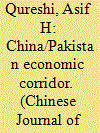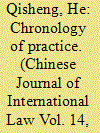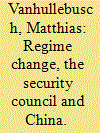| Srl | Item |
| 1 |
ID:
142121


|
|
|
|
|
| Summary/Abstract |
This paper focuses on the China/Pakistan Economic Corridor (CPEC) arrangement between Pakistan and China from a legal and policy standpoint. It takes into account the Chinese Silk Road Economic Belt and 21st Century Maritime Silk Road Vision under which CPEC is set. The paper highlights the relevance of the application of both Pakistani law and international law to CPEC. In particular the paper focuses on some fundamental legal questions, for example the very legal character of CPEC. The discussion on the fundamental legal questions is followed by the various streams of legal frameworks that have a bearing on CPEC including the Pakistani Constitution and world trade and international investment norms. The purpose of this paper is to provide a framework of issues raised by CPEC. It is not intended as an exhaustive analysis of all the issues raised.
|
|
|
|
|
|
|
|
|
|
|
|
|
|
|
|
| 2 |
ID:
142122


|
|
|
|
|
| Summary/Abstract |
This survey covers materials reflecting the practice of private international law in China in 2014. First, this survey contains the reports of the Supreme People's Court (SPC) released in 2014, notably the Report on the Work of the SPC in 2014 as well as the White Book on China's Maritime Adjudication (1984–2014). Second, the survey covers laws and judicial interpretations that were revised or took effect in 2014. The important legal instruments that were affected in 2014 include: The Provisions of the SPC concerning the Trials of Civil Cases Involving Notarial Activities; and the Reply of the SPC concerning the Commencement Date of the Statute of Limitations for Insurers under Marine Insurance Contracts to Exercise Subrogation Rights. Third, this survey particularly focuses on typical cases decided by various Chinese courts during 2014 in the following areas: jurisdiction (exclusive choice of court agreements; non-exclusive choice of court agreements; implied jurisdiction); choice of law (electronic contracts, statute of limitations, application of international conventions); fundamental breach of contract; execution of a foreign-related judgment and enforcement of a foreign judgment; arbitration and foreign awards.
|
|
|
|
|
|
|
|
|
|
|
|
|
|
|
|
| 3 |
ID:
142118


|
|
|
| 4 |
ID:
142119


|
|
|
|
|
| Summary/Abstract |
It is the first time the full tribunal of the ITLOS has entertained a request for advisory opinion. The Tribunal expounded the legal basis of its advisory function under the LOS Convention as well as the prerequisites for the exercise of the jurisdiction in a particular case. The Tribunal held that the flag State has the responsibility to ensure that its vessels do not conduct IUU fishing activities within the EEZ of the coastal State. However, there are some weaknesses in the reasoning of the ITLOS.
|
|
|
|
|
|
|
|
|
|
|
|
|
|
|
|
| 5 |
ID:
142117


|
|
|
|
|
| Summary/Abstract |
This paper explores the protection of non-indigenous human remains under cultural heritage law. By comparing the law for land-based cultural heritage and the law for underwater cultural heritage (UCH), and contrasting the law for dead human bodies and cultural heritage law, it proposes that the law for land-based cultural heritage should draw insights from the law for UCH, which generally distinguishes human remains from other cultural properties and protects the remains regardless whether they are indigenous or not. Before the law for land-based cultural heritage embraces the full protection of human remains regardless of their provenance, the law for dead human bodies may extend protection to ancient corpses that are well preserved, maintain a clear record of life history, are worshiped or protected continuously by later generations, and have become an indispensible part of their spiritual or moral life. These bodies, even if they died hundreds or thousands of years ago, do not lose their human dignity in the eyes of later generations and should be treated as cultural property for personhood.
|
|
|
|
|
|
|
|
|
|
|
|
|
|
|
|
| 6 |
ID:
142116


|
|
|
|
|
| Summary/Abstract |
China's stance on its Five Principles of Peaceful Coexistence is diametrically opposed to its evolving attitude within the Security Council in a number of dossiers where it has lent its support either tacitly or affirmatively to resolutions adopted that endorsed, facilitated, reversed and prevented regime change since the end of the Cold War. Rather than measuring such developments from a conflictual perspective, China's increasing contribution in the international legal and political order, with a view to promoting a so-called harmonious world, may be seen in light of the international law of co-progressiveness and theory of relationality and relational governance respectively espoused by two Chinese international law and relations scholars Sienho Yee and Yaqing Qin.
|
|
|
|
|
|
|
|
|
|
|
|
|
|
|
|
| 7 |
ID:
142120


|
|
|
|
|
| Summary/Abstract |
After being initially drafted in 2001 by an expert body—the International Commission on Intervention and State Sovereignty—the “responsibility to protect” (R2P) doctrine has eventually found its way into the 2005 UN World Summit Outcome document, thereby replacing a morally controversial doctrine of “humanitarian intervention”. The paper aims, first, to point out how these two doctrines are different ethical projects. Second, recognizing that it is safer to say that the doctrine has not become a principle of law, this paper tries to situate it within the prevalent value of the international rule of law. It does so by exploring two somewhat contrasting conceptions—one more substantive in nature, which takes individuals as ultimate beneficiaries of this value, and the other, more formal in nature, which puts states in the forefront. The R2P case shows, however, that neither of them can be advanced to the full extent.
|
|
|
|
|
|
|
|
|
|
|
|
|
|
|
|